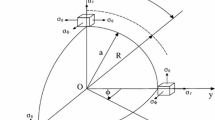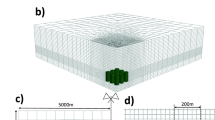Abstract
Salt caverns are internationally recognized as excellent facilities for underground energy storage. Creep shrinkage deformation will occur in deep salt caverns under the action of high-ground stress, and it is a key factor to evaluate the safety of salt caverns. However, there has been no salt cavern creep shrinkage mechanism research on ultra-deep salt caverns. In this paper, the creep shrinkage mechanism of an ultra-deep salt cavern is established from the theory, numerical simulation, and field application. First, the actual creep field experiments (pressure testing and sonar testing) of the salt cavern (depth ≥ 2000 m) are carried out. Second, theoretical models of salt cavern creep shrinkage are established from four influence aspects (creep shrinkage, heat conduction, salt dissolution, and brine permeability). Third, a 3D geological model is built to analyze the creep stability of deep salt caverns based on their field conditions. The novelty of this paper is analyzing the creep shrinkage of the ultra-salt cavern by the theoretical model, numerical model, and field experimental data systematically. The results show that the shrinkage of the salt cavern and brine thermal expansion is key factors leading to pressure lifting of the salt cavern, which accounts for 0.6121 and 0.2147 in the four influence aspects. Three creep phases are obtained: rapid rising stage, steady rising stage and decelerating rising stage. The study provides a reference for the creep shrinkage and field application of salt caverns.
Highlights
-
Creep field experiments of the salt cavern are carried out.
-
Theoretical models of ultra-deep salt cavern creep mechanisms are built.
-
An ultra-deep 3D salt cavern creep numerical model is built to analyze the creep stability of salt caverns.
-
A mathematical model is proposed to analyze the factors that influence salt cavern creep.


















Similar content being viewed by others
Data availability
The data that support the findings of this study can be available from the corresponding author upon reasonable request.
Abbreviations
- SCOS:
-
Salt cavern oil storage
- DEM:
-
Discrete element method
- RPT:
-
Rate process theory
- B :
-
Dilatancy safety factor
- ES:
-
Effective strain
- \(\varepsilon_{\text{v}}\) :
-
The deviatoric strain tensor
- \(J_2\) :
-
The second invariant of deviatoric stress tensor
- \(I_1\) :
-
The first invariant of the stress tensor
- q :
-
The flow rate
- V :
-
The volume of salt cavern
- \(\dot{\varepsilon }_{{\text{cr}}}\) :
-
The salt cavern volume closure rate
- \(\alpha_{\text{b}}\) :
-
Temperature expansion coefficient
- \(\dot{T}_{\text{c}}\) :
-
Derivative of temperature
- \(P_\infty\) :
-
The formation pressure
- \(P_{\text{C}}\) :
-
The salt cavern pressure
- \(T_\infty\) :
-
The ground temperature
- \(b_{ij}\) :
-
The elements in the matrix
- \(\overline{b}_{ij}\) :
-
The elements of the normalized matrix
- AHP:
-
Analytic hierarchy process
- \(\overline{W}_i\) :
-
The matrix that is summed by row
- \(W_i\) :
-
The weight of the AHP model
- \(\dot{P}\) :
-
The pressure rise rate
- \(\dot{T}\) :
-
The temperature rise rate
- \(\alpha , \beta\) :
-
The coefficient of the thermal equation
- K :
-
The overall micro-penetration rate
- \(P_{\text{C}}\) :
-
The brine pressure
- \(P_0\) :
-
The natural pore pressure
- R :
-
The diameter of salt cavern
- \(\eta\) :
-
The dynamic viscosity coefficient
- T :
-
The absolute temperature of salt rock
- \(\dot{\varepsilon }^{ss}\) :
-
The steady strain rate
- \(A^{{\prime}}\), n, Q/R :
-
Three empirical parameters
- \(E_{{\text{salt}}}\) :
-
Young’s modulus
- \(\alpha_{{\text{salt}}}\) :
-
The coefficient of thermal expansion
- \(\dot{\varepsilon }^{{\text{tr}}}\) :
-
The instantaneous strain rate
- \(P_{{\text{wh}}}\) :
-
The diesel pressure
- CI:
-
The consistency index
- CR:
-
The final accuracy index
- RI:
-
The random consistency index
- \(\lambda\) :
-
The maximum eigenvalue
- n :
-
The order of the matrix
References
Abramson D, Komineni J (2003) Interprocess communication in griddles: grid enabling legacy software. Technical report. School of Computer Science and Software Engineering, Monash University
Bérest P (2017) Cases, causes and classifications of craters above salt caverns. Int J Rock Mech Min Sci 100:318–329
Bérest P (2019) Heat transfer in salt caverns. Int J Rock Mech Min Sci 120:82–95
Bérest P, Bergues J, Brouard B, Durup J, Guerber B (2001) A salt cavern abandonment test. Int J Rock Mech Min Sci 38(3):357–368
Brouard B, Berest P, Durup G, de France G (2002) LOSAC©: a first salt cavern abandonment software, SMRI spring conference. Citeseer
Brouard B, Berest P, De Greef V, Béraud JF, Lheur C, Hertz E (2013) Creep closure rate of a shallow salt cavern at Gellenoncourt, France. Int J Rock Mech Min Sci 62:42–50
Chairiyah R, Yetti AE, Pujiyanti I (2022) The Grasshopper+ Rhino for 3D modelling in Indonesian’s education of biomimetic architecture. International Webinar on Digital Architecture 2021 (IWEDA 2021). Atlantis Press, pp 223–229
Cirone A, Vargas E (2023) A thermodynamic modeling of creep in rock salt. Int J Rock Mech Min Sci 162:105298
Cornet JS, Dabrowski M, Schmid W (2018) Long term creep closure of salt cavities. Int J Rock Mech Min Sci 103:96–106
Dong Z, Li Y, Li H, Shi X, Ma H, Zhao K, Zhao A (2022) Influence of loading history on creep behavior of rock salt. J Energy Storage 55:105434
Durup J, Vidal F, Rolin C (2007) Pilot abandonment test of a very deep gas storage salt cavern. Oil Gas Sci Technol Revue De l’IFP 62(3):287–296
Gao R, Wu F, Chen J, Zhu C, Ji C (2022) Study on creep characteristics and constitutive model of typical argillaceous salt rock in energy storage caverns in China. J Energy Storage 50:104248
Gutiérrez-Ch JG, Senent S, Graterol EP, Zeng P, Jimenez R (2023) Rock shear creep modelling: DEM—rate process theory approach. Int J Rock Mech Min Sci 161:105295
Li W, Miao X, Yang C (2020) Failure analysis for gas storage salt cavern by thermo-mechanical modelling considering rock salt creep. J Energy Storage 32:102004
Liu X, Yang X, Wang J (2015) A nonlinear creep model of rock salt and its numerical implement in FLAC 3D. Adv Mater Sci Eng 2015:1
Lyu C, Liu J, Zhao C, Ren Y, Liang C (2021) Creep-damage constitutive model based on fractional derivatives and its application in salt cavern gas storage. J Energy Storage 44:103403
Ma L, Wang Y, Wang M, Xue B, Duan L (2021) Mechanical properties of rock salt under combined creep and fatigue. Int J Rock Mech Min Sci 141:104654
Mitchell KE (2000) Tecplot 8.0. Science 290(5499):2097–2097
Nazary Moghadam S, Nazokkar K, Chalaturnyk RJ, Mirzabozorg H (2015) Parametric assessment of salt cavern performance using a creep model describing dilatancy and failure. Int J Rock Mech Min Sci 79:250–267
Özşen H, Özkan İ, Şensöğüt C (2014) Measurement and mathematical modelling of the creep behaviour of Tuzköy rock salt. Int J Rock Mech Min Sci 66:128–135
Ratigan J (2003) The solution mining research institute cavern sealing and abandonment program 1996–2002. In: Proceedings of the SMRI spring meeting
Thoraval A, Lahaie F, Brouard B, Berest P (2015) A generic model for predicting long-term behavior of storage salt caverns after their abandonment as an aid to risk assessment. Int J Rock Mech Min Sci 77:44–59
Wang T, Yan X, Yang H, Yang X, Jiang T, Zhao S (2013) A new shape design method of salt cavern used as underground gas storage. Appl Energy 104:50–61
Wang T, Yang C, Shi X, Ma H, Li Y, Yang Y, Daemen JJK (2015) Failure analysis of thick interlayer from leaching of bedded salt caverns. Int J Rock Mech Min Sci 73:175–183
Wang T, Yang C, Ma H, Li Y, Shi X, Li J, Daemen JJK (2016) Safety evaluation of salt cavern gas storage close to an old cavern. Int J Rock Mech Min Sci 83:95–106
Wang TT, Ma HL, Shi XL, Yang CH, Zhang N, Li J (2018) Salt cavern gas storage in an ultra-deep formation in Hubei, China. Int J Rock Mech Min Sci 102:57–70
Wang J, Zhang Q, Song Z, Zhang Y (2021a) Experimental study on creep properties of salt rock under long-period cyclic loading. Int J Fatigue 143:106009
Wang T, Chai G, Cen X, Yang J, Daemen JJK (2021b) Safe distance between debrining tubing inlet and sediment in a gas storage salt cavern. J Petrol Sci Eng 196:107707
Wang J, Zhang Q, Liu X, Song Z, Feng S (2022) Creep properties and constitutive model for salt rock subjected to uniaxial trapezoidal cyclic loading. J Energy Storage 52:105023
Wei X, Shi X, Hu W, Ban S, Li Y, Ma H (2023) Dynamic tightness evaluation of salt cavern energy storage. J Energy Storage 57:106313
Wu F, Zhang H, Zou Q, Li C, Chen J, Gao R (2020) Viscoelastic-plastic damage creep model for salt rock based on fractional derivative theory. Mech Mater 150:103600
Yang C, Wang T, Chen H (2022) Theoretical and technological challenges of deep underground energy storage in China. Engineering 2022:1
Zhang H, Wang Z, Zheng Y, Duan P, Ding S (2012) Study on tri-axial creep experiment and constitutive relation of different rock salt. Saf Sci 50(4):801–805
Zhang G, Li Y, Daemen JJ, Yang C, Wu Y, Zhang K, Chen Y (2015) Geotechnical feasibility analysis of compressed air energy storage (CAES) in bedded salt formations: a case study in Huai’an City, China. Rock Mech Rock Eng 48:2111–2127
Zhao K, Liu Y, Li Y, Ma H, Hou W, Yu C (2022) Feasibility analysis of salt cavern gas storage in extremely deep formation: a case study in China. J Energy Storage 47:103649
Zhao K, Yang C, Ma H, Daemen JJK (2023) A creep-fatigue model of rock salt and its application to the deformation analysis of CAES salt caverns. Comput Geotech 156:105311
Zhou HW, Wang CP, Han BB, Duan ZQ (2011) A creep constitutive model for salt rock based on fractional derivatives. Int J Rock Mech Min Sci 48(1):116–121
Acknowledgements
The authors wish to acknowledge the Excellent Young Scientists Fund Program of the National Natural Science Foundation of China (No. 52122403), the Youth Innovation Promotion Association CAS (Grant No. 2019324), and the CAS Hundred Talents Program (Grant No. Y826031C01). Acknowledging the Wei Hu in SINOPEC Research Institute of Petroleum Engineering Co., Ltd, Qianjiang, Hubei.
Author information
Authors and Affiliations
Corresponding author
Additional information
Publisher's Note
Springer Nature remains neutral with regard to jurisdictional claims in published maps and institutional affiliations.
Rights and permissions
Springer Nature or its licensor (e.g. a society or other partner) holds exclusive rights to this article under a publishing agreement with the author(s) or other rightsholder(s); author self-archiving of the accepted manuscript version of this article is solely governed by the terms of such publishing agreement and applicable law.
About this article
Cite this article
Wei, X., Shi, X., Li, Y. et al. Field Experimental and Theoretical Research on Creep Shrinkage Mechanism of Ultra-Deep Energy Storage Salt Cavern. Rock Mech Rock Eng 57, 287–305 (2024). https://doi.org/10.1007/s00603-023-03549-z
Received:
Accepted:
Published:
Issue Date:
DOI: https://doi.org/10.1007/s00603-023-03549-z




